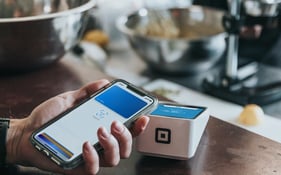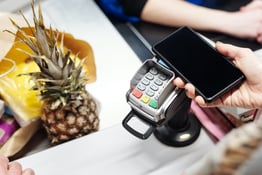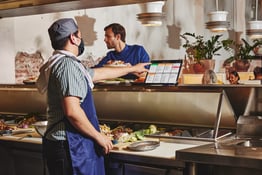Udi Shamai has spent decades in the fast food space building restaurants from the ground up, formerly as the CEO of Domino’s Pizza Israel and currently as the owner of Pizza Hut Israel. Soon, he expects to open hundreds of additional restaurant operations – this time, in the form of fully automated concepts that can pump out food without the need for a single person inside.
Shamai launched Hyper Food Robotics last November, starting with a pizza-making prototype the size of a 40-foot shipping container that can produce 50 pies an hour. Located just outside of Tel Aviv, the model operates using two robotic arms, 120 sensors, and 20 AI-powered cameras. It’s capable of serving a menu featuring four kinds of dough, eight toppings, and several side dishes.
Driven by a desire to solve labor and food safety inefficiencies in the industry, Shamai expects to sell hundreds of Hyper’s plug-and-play pizza concepts in the next few years, with the goal of not only partnering with existing brands, but dark kitchen companies and third party platforms, too. The company is currently working on technology to double the number of pies produced per hour and triple the number of topping options. It also plans to expand to other types of food, ranging from bowl food to burgers to ice cream.
We sat down to chat with Shamai to learn more about how Hyper’s technology works and the role he sees autonomous technology playing in the future of the restaurant industry.
I’d love to hear more about your inspiration for building Hyper Food Robotics.
We all know that there’s a serious problem today in the industry in terms of human labor. The other thing is, we train so many people, but then in three or four months, they’re gone. You expect people to do an excellent job, but you find yourself training all the time. Then, a lot of food gets thrown out because of reasons related to accuracy.
So the idea was that if we can build an autonomous store, we can solve those problems. This isn’t supposed to replace brick-and-mortar restaurants [altogether] because people still want to go out and experience the entertainment of restaurants. But this is for delivery, where the actual store doesn't really matter.
So we ghosted the ghost kitchen. With the ghost kitchen, it doesn’t matter where it’s located. We took that idea but made it autonomous. And now you're getting a really accurate product.
Can you explain why autonomous operations make it easier to increase accuracy and reduce food waste?
There are a few elements that work together. First is the AI [artificial intelligence] camera that’s analyzing the state of the product at all times. It’s taking pictures of every single item and talking to the robot. The communication makes the robot dead accurate. For example, if the pizza is half a degree to the right – the robot knows how to adjust itself to this degree.
We’re throwing away significantly less food because of the accuracy. When you go to a restaurant, and people are assembling a pizza, they’re throwing the toppings on, and it’s a mess. But if you look at the surface where the robot’s working, you see almost zero cheese or tomatoes outside the pizza.
Another example of how you can control storage and food waste is when you think about dough. When you’re a restaurant, you proof 200 discs of dough because you expect to sell 200 pizzas. But let’s say it’s a slow evening – in a normal store, you’d have to throw away the dough because you can’t overproof it. What we do, if sales aren’t going that well, we have a computer system that drops the temperature system of the dough to stop it from proofing. You can control it, and if things are picking back up, you can take the temperature up.
Give us a rundown of how Hyper’s current prototype operates.
The dough comes in externally from the brand and goes into storage. When a customer places an order, the robotic arm goes and picks out the right dough, and then it goes into a dispensing area where the sauce and toppings are displayed. After assembly, production stops for a second because the AI camera is doing an analysis on what the robot just did. If it’s OK, [the robot] puts it into the oven, and if not, it shuffles it to the left where a different robot takes care of it.
When it comes out of the oven, the AI camera takes a temperature reading and a picture to analyze the color of the dough. There’s a supersonic knife that cuts the pizza. Then above the unit, there’s a place where the cartons are, and a robot makes them into a box. The pizza goes into the box, and then it goes through a metal detector. Because there are machines involved, like in a factory, this is detecting that no screws or anything fell into it. After the metal detector, it goes to bundling – that’s when it gets paired with Coke, a side dish, or whatever. Then it’s put into a drawer that functions almost like an ATM, so the customer can pick it up or there’s a special hatch for delivery people.
How many staff members are required to oversee the process?
The store doesn’t need anyone inside, but somebody has to feed the machine. So everyday, someone comes in with ingredients – special cartridges that are loaded into the containers.
So you need one person for logistics, and we also have six people on the ground for a cluster of 30 stores to act as technicians to fix things, if needed. Above this, we have a control room that oversees hundreds of stores. There are some functions that need people on the ground, and some that can be done remotely. An example is if the electricity goes out – then nothing would work.
And there’s no manual cleanup, right?
Having to clean all these specific machines is very challenging – the cleaning is the biggest challenge of all. We are cleaning with ozone water, meaning there’s no chemicals.
Nothing can live in an ozone environment, which means no bacteria and no insects. Even we can’t go in. Ozone is a gas, so by default when you clean with ozone, you have ozone in the air, and people can’t breathe ozone. That means if there’s a problem in the store, we’d have to wait 40 minutes before we can step inside. It’s sprayed, like in a sprinkler system, and there’s a steam that goes over the conveyor belts.
How does a partnership between Hyper and an operator work?
We sell the stores to them and we’re doing all of the operations except for the chain supply, delivery, and marketing. But it’s their store and brand. We get a fee for running it on the ground for them. The fee changes from brand to brand and depends on how many people we need on the ground and how many stores are in a geographical location. If there are two stores, and we need six people, that would be very costly, but if there are 60 stores within 120 miles, then it’s more efficient.
Pizza is a popular item among fully automated restaurant concepts. Why do you think it’s a starting point for so many companies?
Pizza is the fastest moving item in delivery, and with the business model, you need something that has high volume with delivery. Plus, with an online business, people don’t really care where the pizza’s coming from, as long as it’s done safely and it’s good quality.
We’re now doing the burger, which we want to introduce at the end of this year. Unlike with pizza, where we’re tracking step by step to replicate the same way pizza’s already made, the burger is being produced completely differently. It’s using a different [type of automated] station, and I think you're getting a much better product than you have today. It’s a very juicy patty. We figured out how to lose less weight by doing it in induction rather than on the broiler, and that changes the moisture inside the patties.
Was it harder to develop technology that can make burgers?
It’s an interesting question, and it depends on who you’re asking. We have a CTO who’s really a brilliant guy, and he always says to me, “Udi, robotics is for fools. Automation is for smart people.”
The reason he says that is, robotics are taking too much space in the way they move. It imitates a human being. While in automation, it does what it needs but in a very small area, very quickly, and it doesn’t waste moves. With the burger, we’re using more automated systems. But you have to be brilliant to do automation. If you look at xRobotics, it’s all automation, and they probably spent years figuring out how to do it the best way, without any robotic arms. Automation is all about information, while being so efficient.
How quickly do you expect to see more advanced cooking methods and food options emerging in the automated restaurant space?
I think the future is here. I know a lot of companies are just getting started, but people are starting to understand that because of the shortage of labor, we need to do something. So a lot of competitors are coming in. And if I’m right, in just a few years, delivery will be completely autonomous. We’re going to see all delivery systems – any food that goes into delivery – go through an autonomous store.
I could be wrong, but this is my view, and I can see it happening right now. So many great minds are going into this industry, and it’s evolving. And there’s no way it’s going to stop because it makes sense. It’s smart. It’s more efficient. You’re getting better and safer products. And an important thing people aren’t really speaking about is that it’s going to take the price of food down. You’re going to have people saying, “Listen, we used to make 14% EBITDA, [earnings before interest, taxes, depreciation, and amortization], and now we’re making 35%, and we have to give some to the clients.” I’m not worried about the competition – I think it’s exciting. I want people to succeed with this because it really brings a different world.
Beyond minimizing staff, what are the primary ways in which an automated restaurant like Hyper maximizes profits for the operator?
Just with zero labor, you have 35% more [revenue] than you did before. But you also have lower rental because you’re placing the store in places that aren’t super prime locations. With Hyper, you have about one-third of operation expenses because you’re not using any chemical cleaning products, and there are so many other operational elements that aren’t required in an autonomous store. Adding all these variables, you can expect to triple profits, which is a huge thing for the industry. And, again, this is going to drop fast food prices around the world, because once you have three, four, five players doing this, they have to give to the consumer to stay competitive.
This was designed for the fast-food industry, but can you share more details about exactly who’s your target audience, on the operator side?
The two biggest players are dark kitchens, like CloudKitchens and REEF Technology, and also aggregators, like DoorDash, Uber Eats, and Grubhub. They’re going to build their own brands in the end because that’s the only way they’re going to make money.
It took me 15 years to build 100 Pizza Hut stores. With Hyper, I can do this in two months. You plug-and-play with four elements: electricity, water, sewage, and communication. Then you’re up and running. So you can place hundreds of stores, and you can build a chain that never existed before, if you have the audience, like the captive audience of DoorDash. Then bingo – pizza, burger, bowl food, ice cream, salads, with a captive audience, these aggregators can do anything they want.
Then the regular players like McDonald’s, they have stores already. So for them, it’s interesting, but they’ll look for models where you substitute some stations [with autonomous elements], rather than having a fully autonomous solution.
Where do you see your own company growing in the future?
We want to redesign the whole fast-food segment in terms of making everything autonomous. In the next few years, we’ll start selling hundreds of stores. If we partner with just one aggregator or dark kitchen or with Pizza Hut, they’re going to be looking for a couple hundred stores right there.
By the end of the year, we’re looking at having a couple of our V1 stores running for different pizza brands, but it’s confidential, so we can’t share who we’re partnering with.
What do you see as your greatest challenges as the company grows?
Our biggest challenge is how fast we can build stores. We’re now assembling stores, and we want to go into production. Production is something you go into with people like with Toyota, General Motors – big companies that are doing machinery and can build stores really fast. So now our biggest challenge is to take a jump, the quantum leap, and move from assembling stores to a full production line somewhere. That’s what we’re focusing on right now.





